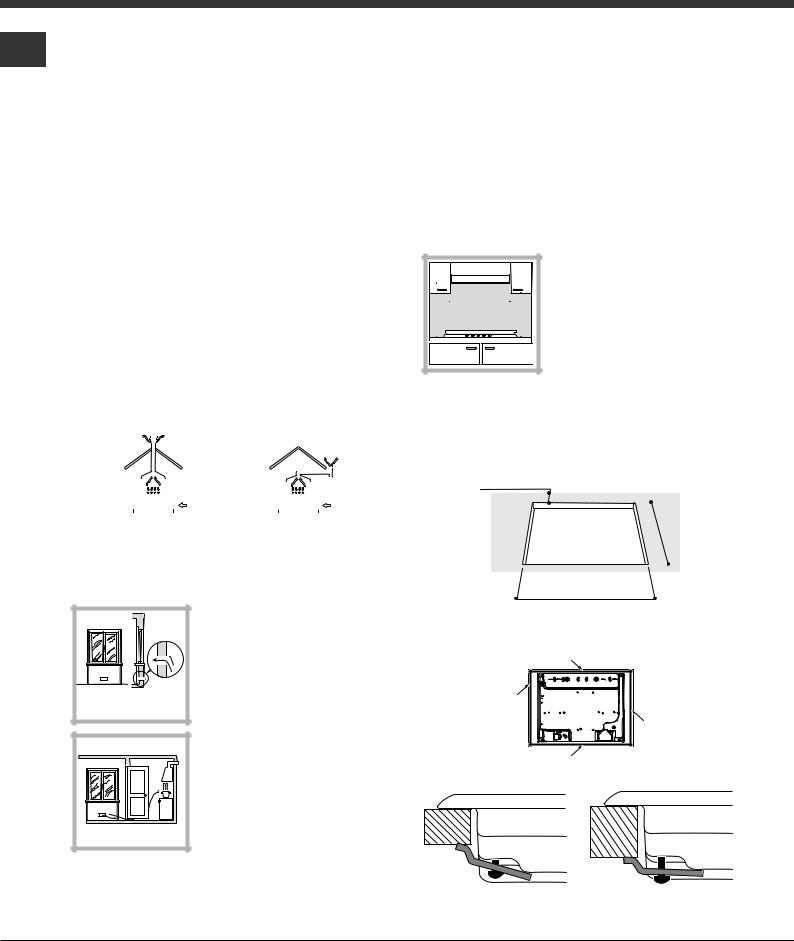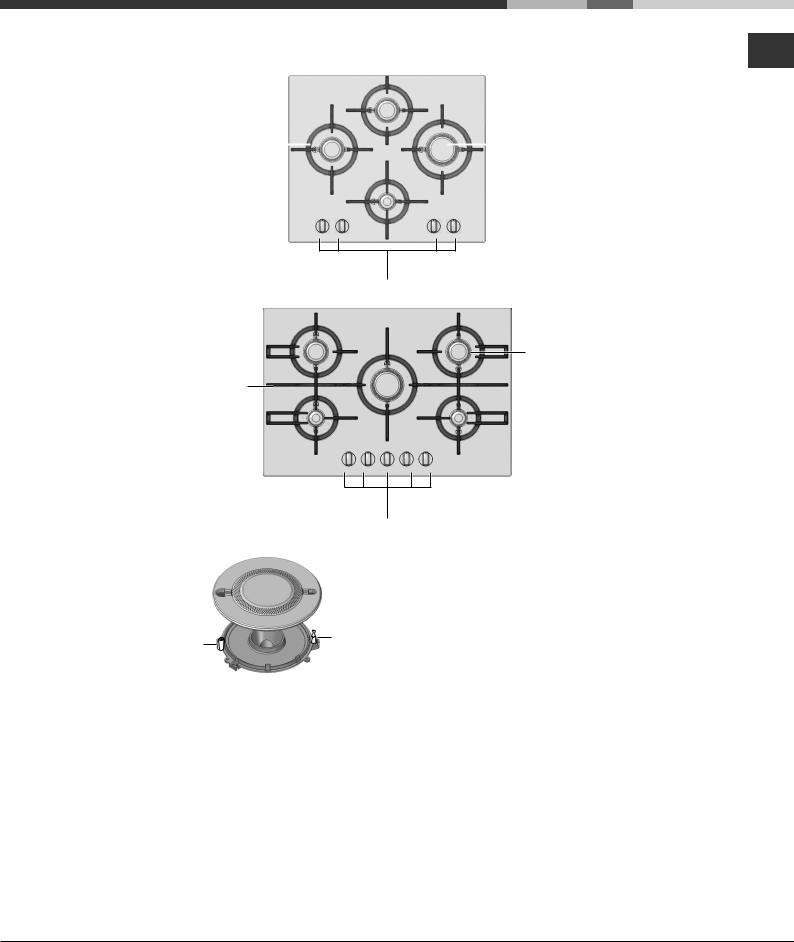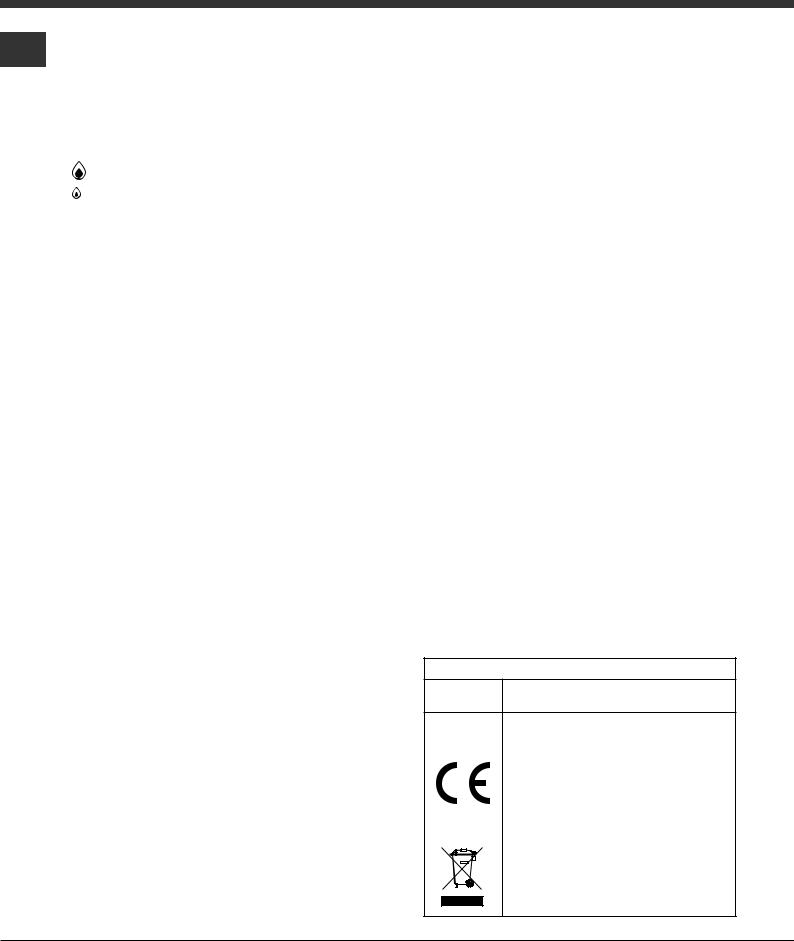Hotpoint 7HPKQ 644D GH, 7HPK 755 D GH X /HA, 7HPK 644 D GH X /HA, 7HPKQ 755D GH Manual

Operating Instructions
GB RS
English, 1 |
Русский, 10 |
7HPK 644 D GH X /HA 7HPKQ 644 D GH /HA 7HPK 755 D GH X/HA 7HPKQ 755 D GH /HA
HOB
Contents
GB
Installation, 2-4
Positioning Electrical connection Gas connection
Burner and nozzle specifications
Description of the appliance, 5
Overall view
Start-up and use, 6
Practical advice on using the burners
Data plate
Precautions and tips, 7
General safety
Disposal
Maintenance and care, 8
Switching the appliance off
Cleaning the appliance
Gas tap maintenance
Troubleshooting, 9
1

Installation
! Before operating your new appliance please read this
GB instruction booklet carefully. It contains important information for safe use, installation and care of the appliance.
! Please keep these operating instructions for future reference. Pass them on to possible new owners of the appliance.
Positioning
!Keep packaging material out of the reach of children. It can become a choking or suffocation hazard (see Precautions and tips).
!The appliance must be installed by a qualified professional according to the instructions provided. Incorrect installation may cause harm to people and animals or may damage property.
!This unit may be installed and used only in permanently ventilated rooms in accordance with British Standard Codes Of Practice: B.S. 6172 / B.S. 5440, Par. 2 and B.S. 6891 Current Editions. The following requirements must be observed:
•The room must be equipped with an air extraction system that expels any combustion fumes. This may consist of a hood or an electric fan that automatically starts each time the appliance is switched on.
|
|
|
|
|
|
|
|
|
|
|
|
|
|
|
|
|
|
|
|
|
|
|
|
|
|
|
|
|
|
|
|
|
|
|
|
|
|
|
|
|
|
|
|
|
|
|
|
|
|
|
|
|
|
|
|
|
|
|
|
|
|
|
|
|
|
|
|
|
|
|
|
|
|
|
|
|
|
|
|
|
|
|
|
|
|
|
|
|
|
|
|
|
|
|
|
|
|
|
|
|
|
|
|
|
|
|
|
|
|
|
|
|
|
|
|
|
|
|
|
|
|
|
|
|
|
In a chimney stack or branched flue. |
Directly to |
|
|
|
|
|||||||||||||||
(exclusively for cooking appliances) |
the Outside |
|
|
|
|
|||||||||||||||
|
|
|
|
|
|
|
|
|
|
|
|
|
|
|
|
|
|
|
|
|
•The room must also allow proper air circulation, as air is needed for combustion to occur normally. The flow of air
must not be less than 2 m3/h per kW of installed power. The air circulation system may
take air directly from the outside
by means of a pipe with an inner
cross section of at least 100 cm2; the opening must not be vulnerable to any type of blockages.
Adjacent |
Room to be |
Room |
Vented |
Enlarging the ventilation slot |
|
between window and floor. |
|
The system can also provide the air needed for combustion indirectly, i.e. from adjacent rooms fitted with air circulation tubes as described above. However, these rooms must not be communal rooms, bedrooms or rooms that may present a fire hazard.
Fitting the appliance
Gas and mixed hobs are manufactured with type X degree protection against overheating. The following precautions must be taken when installing the hob:
•Kitchen cabinets adjacent to the appliance and taller than the top of the hob must be at least 600 mm from the edge of the hob.
•Hoods must be installed according to their relative installation instruction manuals and at a minimum distance of 650 mm from the hob.
•Place the wall cabinets adjacent to the hood at a minimum height of 420 mm from the hob (see figure).
|
600mm min. |
700mmmin. |
600mmmin. |
If the hob is installed beneath a wall cabinet, the latter must be situated at a minimum of 700 mm above the hob (see figure).
•The installation cavity should have the dimensions indicated in the figure. Fastening hooks are provided, allowing you to fasten the hob to tops that are between 20 and 40 mm thick. To ensure the hob is securely fastened to the top, we recommend you use all the
hooks provided.
55 mm
475 mm
555 mm
•Before fastening the cooktop in place, position the seal (supplied) along the perimeter of the countertop, as shown in the figure.
Hook fastening diagram
Hooking position |
Hooking position |
for top H=20 mm |
for top H=30 mm |
2

Front
|
|
Back |
|
|
|
|
|
|
|
|
|
Hooking position |
|
||
for top H=40 mm |
|
|
|
! Use the hooks contained in the “accessory pack”
•Where the hob is not installed over a built-in oven, a wooden panel must be installed as insulation. This must be placed at a minimum distance of 20 mm from the lower part of the hob.
Ventilation
To ensure adequate ventilation, the back panel of the cabinet must be removed. It is advisable to install the oven so that it rests on two strips of wood, or on a completely flat surface with an opening of at least 45 x 560 mm (see diagrams).
. |
45 |
mm |
. |
mm |
|
||
560 |
|
|
|
! The hob can only be installed above built-in ovens with a cooling ventilation system.
Electricalconnection
Hobs equipped with a three-pole power supply cable are designed to operate with alternating current at the voltage and frequency indicated on the data plate (this is located on the lower part of the appliance). The earth wire in the cable has a green and yellow cover. If the appliance is to be installed above a built-in electric oven, the electrical connection of the hob and the oven must be carried out separately, both for electrical safety purposes and to make extracting the oven easier.
Connecting the supply cable to the mains
Install a standardised plug corresponding to the load indicated on the data plate.
The appliance must be directly connected to the mains using an omnipolar circuit-breaker with a minimum contact opening of 3 mm installed between the appliance and the mains. The circuit-breaker must be suitable for the charge indicated
and must comply with current electrical regulations (the
earthing wire must not be interrupted by the circuit-breaker). GB The supply cable must not come into contact with surfaces
with temperatures higher than 50°C.
! The installer must ensure that the correct electrical connection has been made and that it is compliant with safety regulations.
Before connecting to the power supply, make sure that:
•The appliance is earthed and the plug is compliant with the law.
•The socket can withstand the maximum power of the appliance, which is indicated on the data plate.
•The voltage is in the range between the values indicated on the data plate.
•The socket is compatible with the plug of the appliance. If the socket is incompatible with the plug, ask an authorised technician to replace it. Do not use extension cords or multiple sockets.
!Once the appliance has been installed, the power supply cable and the electrical socket must be easily accessible.
!The cable must not be bent or compressed.
!The cable must be checked regularly and replaced by authorised technicians only (see Assistance).
!The manufacturer declines any liability should these safety measures not be observed.
Gas connection
The appliance should be connected to the main gas supply or to a gas cylinder in compliance with current national regulations. Before carrying out the connection, make sure the cooker is compatible with the gas supply you wish to use.
! Check that the pressure of the gas supply is consistent with the values indicated in Table 1 (“Burner and nozzle specifications”). This will ensure the safe operation and longevity of your appliance while maintaining efficient energy consumption.
Connection with a rigid pipe (copper or steel)
! Connection to the gas system must be carried out in such a way as not to place any strain of any kind on the appliance.
There is an adjustable L-shaped pipe fitting on the appliance supply ramp and this is fitted with a seal in order to prevent leaks. The seal must always be replaced after rotating the pipe fitting (seal provided with appliance). The gas supply pipe fitting is a threaded 1/2 gas cylindrical male attachment.
3

Connecting a flexible jointless stainless steel pipe to a
GB |
threaded attachment |
|
|
|
The gas supply pipe fitting is a threaded 1/2 gas |
|
cylindrical male attachment. |
|
These pipes must be installed so that they are never |
|
longer than 2000 mm when fully extended. Once |
|
connection has been carried out, make sure that the |
|
flexible metal pipe does not touch any moving parts and |
|
is not compressed. |
|
! Only use pipes and seals that comply with current |
|
national regulations. |
Checking the tightness of the connection
!When the installation process is complete, check the pipe fittings for leaks using a soapy solution. Never use a flame.
!Should the gas pressure used be different (or vary slightly) from the recommended pressure, a suitable pressure regulator must be fitted to the inlet pipe (in order to comply with current national regulations).
Burner and nozzle specifications
Table 1 |
|
|
|
|
Natural Gas |
Adjusting the burner’s |
||
|
|
|
|
|
(G20 / 20 mbar) |
primary air |
||
|
|
|
|
|
|
|
|
|
Burner |
Diameter |
Thermal Power |
Nozzle |
|
Flow* |
|
||
|
(mm) |
kW (p.c.s.*) |
1/100 |
|
l/h |
|
||
|
|
Nomin. |
|
Reduc. |
(mm) |
|
(G20) |
(mm) |
|
|
|
|
|||||
|
|
|
|
|
|
|
|
|
Fast (R) |
157 |
3.00 |
|
1.00 |
125 |
|
286 |
4.7 |
|
|
|
|
|
|
|
|
|
Semi Fast (S) |
132 |
1.90 |
|
0.80 |
100 |
|
157 |
2.6 |
|
|
|
|
|
|
|
|
|
Auxiliary (A) |
110 |
1.00 |
|
0.50 |
72 |
|
95 |
2 |
|
|
|
|
|
|
|
|
|
Supply pressures |
Nominal (mbar) |
|
20 |
|
||||
Minimum (mbar) |
|
17 |
|
|||||
|
Maximum (mbar) |
|
25 |
|
||||
|
|
|
|
|
|
|
|
|
*At 15°C and 1013 mbar-dry gas Natural P.C.S. = 37.78 MJ/m³
|
S |
S |
S |
S |
R |
|
R |
|
A |
A |
A |
7HPK 644 D GH X /HA 7HPKQ 644 D GH /HA
7HPK 755 D GH X/HA 7HPKQ 755 D GH /HA
4

Description of the appliance
Overall view
GB
Support Grid for |
|
|
|
GAS BURNERS |
|
|
|
||
COOKWARE |
|
|
|
|
Control Knobs for
GAS BURNERS
GAS BURNERS
Support Grid for
COOKWARE
Control Knobs for
GAS BURNERS
Ignition for
SAFETY
GAS BURNERS
DEVICES
! The largest slot should be inserted into the ignition.
•GAS BURNERS differ in size and power. Use the diameter of the cookware to choose the most appropriate burner to cook with.
•Control Knobs for GAS BURNERS adjust the size of the flame.
•GAS BURNER ignition enables a specific burner to be lit automatically.
•SAFETY DEVICE stops the gas flow if the flame is accidentally extinguished.
5

Start-up and use
! The position of the corresponding gas burner or
GB |
electric hotplate* is shown on every knob. |
|
|
||
|
Gas burners |
|
|
Each burner can be adjusted to one of the following |
|
|
settings using the corresponding control knob: |
|
|
• |
Off |
|
|
Maximum |
|
|
Minimum |
To turn on one of the burners, place a lighted match or lighter near the burner, press the knob all the way in and turn it anti-clockwise to the "High" setting.
The knob must be pressed in for about 6 seconds until the device that keeps the flame lit warms up. Some models are equipped with an ignition button incorporated into the control knob. If this is the case, the ignitor is present. To light a burner, simply press the corresponding knob all the way in and then turn it anti-clockwise to the "High" setting, keeping it pressed in until the burner lights.
! If a flame is accidentally extinguished, turn off the control knob and wait for at least 1 minute before trying to relight it.
To switch off the burner, turn the knob in a clockwise direction until it stops (when reaches the “•” position).
Practical advice on using the burners
To ensure the burners operate efficiently:
•Use appropriate cookware for each burner (see table) so that the flames do not extend beyond the bottom of the cookware.
•Always use cookware with a flat base and a cover.
•When the contents of the pan reach boiling point, turn the knob to minimum.
Burner |
Ø Cookware Diameter (cm) |
|
|
Fast (R) |
24 - 26 |
|
|
Semi Fast (S) |
16 - 20 |
|
|
Auxiliary (A) |
10 - 14 |
|
|
To identify the type of burner, refer to the designs in the section entitled, "Burner and Nozzle Specifications".
! Make sure the pans do not overlap the edges of the hob while it is being used.
DATA PLATE
Electrical
connections see data plate
This appliance conforms to the following
European Economic Community directives:
-2006/95/EEC dated 12/12/06 (Low Voltage) and subsequent amendments
-2004/108/EEC dated 15/12/04 (Electromagnetic Compatibility) and subsequent amendments
-93/68/EEC dated 22/07/93 and subsequent amendments.
- 2009/142/EEC dated 30/11/09 (Gas) and subsequent amendments.
- 2002/96/EC and subsequent amendments.
6
